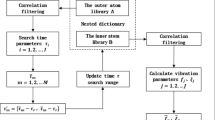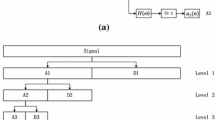Abstract
Vibration-based bearing condition monitoring of rotating machinery is of great importance for improving production efficiency and ensuring operational safety in the manufacturing industry. Sparse representation is able to effectively extract inherent impulse features from fault vibration signals corrupted by noise and harmonic interference, of which the performance is directly determined by dictionaries. In this study, the typical drawbacks of commonly used dictionaries are addressed using a novel cascaded dictionary. Period-assisted bi-damped wavelets with specific shapes are employed as the initial dictionary atoms to achieve overall matches with impulse features. Subsequently, the initial atoms are subjected to the K-singular value decomposition (K-SVD) for a secondary learning to obtain a cascaded dictionary that matches the real impulse features globally and locally. Finally, faulty vibration signals are recovered in segments using the cascaded dictionary and orthogonal matching pursuit (OMP). The results on the signals from the simulations, experiments, and real-world engineering confirm that the proposed cascaded dictionary consistently outperforms three other leading methods. Furthermore, the proposed cascaded dictionary is proved to be suitable for practical engineering diagnosis because of its outstanding anti-noise capabilities and self-adaptability.





















Similar content being viewed by others
Data availability
The data used to support the finding of this study are available from the corresponding author upon request.
Code availability
The algorithm described in this paper is still being studied by the research group, so the code has not been publicly disclosed.
References
Liang M, Cao P, Tang J (2021) Rolling bearing fault diagnosis based on feature fusion with parallel convolutional neural network. Int J Adv Manuf Technol 112(3):819–831. https://doi.org/10.1007/s00170-020-06401-8
Youcef Khodja A, Guersi N, Saadi MN, Boutasseta, N (2020) Rolling element bearing fault diagnosis for rotating machinery using vibration spectrum imaging and convolutional neural networks. Int J Adv Manuf Technol 106(5):1737-1751. https://doi.org/10.1007/s00170-019-04726-7
Ma H, Li S, Lu J, Gong S, Yu T (2022) Impulsive wavelet based probability sparse coding model for bearing fault diagnosis. Measurement 194:110969. https://doi.org/10.1016/j.meaurement.2022.110969
Chen G, Yan C, Meng J, Wang H, Wu L (2021) Improved VMD-FRFT based on initial center frequency for early fault diagnosis of rolling element bearing. Meas Sci Technol 32(11):115024. https://doi.org/10.1088/1361-6501/ac1613
Lu Y, Xie R, Liang S (2019) Bearing fault diagnosis with nonlinear adaptive dictionary learning. Int J Adv Manuf Technol 102(9):4227–4239. https://doi.org/10.1007/s00170-019-03455-1
Song Y, Liu J, Chu N, Wu P, Wu D (2019) A novel demodulation method for rotating machinery based on time-frequency analysis and principal component analysis. J Sound Vib 442:645–656. https://doi.org/10.1016/j.sv.2018.11.024
Li H, Liu T, Wu X, Chen Q (2020) An optimized VMD method and its applications in bearing fault diagnosis. Measurement 166:108185. https://doi.org/10.1016/j.measurement.2020.108185
Wang H, Du W (2021) Early weak fault diagnosis of rolling element bearing based on resonance sparse decomposition and multi-objective information frequency band selection method. J Vib Control. https://doi.org/10.1177/10775463211020205
Chui C, Jiang Q, Li L, Lu J (2021) Analysis of an adaptive short-time Fourier transform-based multicomponent signal separation method derived from linear chirp local approximation. J Comput Appl Math 396:113607. https://doi.org/10.1016/j.cam.2021.11360107
Liu D, Cheng W, Wen W (2020) Rolling bearing fault diagnosis via STFT and improved instantaneous frequency estimation method. Procedia Manuf 49:166–172. https://doi.org/10.1016/j.promfg.2020.07.014
Chen B, Shen B, Chen F, Tian H, Xiao W, Zhang F, Zhao C (2019) Fault diagnosis method based on integration of RSSD and wavelet transform to rolling bearing. Measurement 131:400–411. https://doi.org/10.1016/j.measurment.2018.07.0432018.07.043
Zhang K, Ma C, Xu Y, Chen P, Du J (2021) Feature extraction method based on adaptive and concise empirical wavelet transform and its applications in bearing fault diagnosis. Measurement 172:108976. https://doi.org/10.10116/j.measument.2021.108976
Gu J, Peng Y (2021) An improved complementary ensemble empirical mode decomposition method and its application in rolling bearing fault diagnosis. Digital Signal Process 113:103050. https://doi.org/10.1016/j.dsp.2021.-103050
Dogan S, Tuncer T (2021) A novel statistical decimal pattern-based surface electromyogram signal classification method using tunable q-factor wavelet transform. Soft Comput 25(2):1085–1098. https://doi.org/10.1007/s00500-020-05205-y
Zhang S, Liu Z, He S, Wang J, Chen L (2022) Improved double TQWT sparse representation using the MQGA algorithm and new norm for aviation bearing compound fault detection. Eng Appl Artif Intell 110:104741. https://doi.org/10.1016/j.engappai.2022.104741
Mallat SG, Zhang Z (1993) Matching pursuits with time-frequency dictionaries. IEEE Trans Signal Process 41(12):3397–3415. https://doi.org/10.1109/78.258082
Qin Y, Mao Y, Tang B (2013) Vibration signal component separation by iteratively using basis pursuit and its application in mechanical fault detection. J Sound Vib 332(20):5217–5235. https://doi.org/10.1016/j-.jsv.2013.04.021
Wang S, Selesnick IW, Cai G, Ding B, Chen X (2019) Synthesis versus analysis priors via generalized minimax-concave penalty for sparsity-assisted machinery fault diagnosis. Mech Syst Signal Process 127:202–233. https://doi.org/10.1016/j.ymssp.2019.02.053
Li J, Wang H, Song L (2021) A novel sparse feature extraction method based on sparse signal via dual-channel self-adaptive TQWT. Chin J Aeronaut 34(7):157–169. https://doi.org/10.1016/j.cja.2020.06.013
Song L, Yan R (2019) Bearing fault diagnosis based on cluster-contraction stage-wise orthogonal-matching-pursuit. Measurement 140:240–253. https://doi.org/10.1016/j.measurement.-2019.03.061
Jiang F, Ding K, He G, Du C (2021) Sparse dictionary design based on edited cepstrum and its application in rolling bearing fault diagnosis. J Sound Vib 490:115704. https://doi.org/10.1016/j.jsv.2020.115704
Li Y, Zheng F, Xiong Q, Zhang W (2021) A secondary selection-based orthogonal matching pursuit method for rolling element bearing diagnosis. Measurement 176:109199. https://doi.org/10.1016/j.measurement.2021.109199
Sun R, Yang Z, Zhai Z, Chen X (2019) Sparse representation based on parametric impulsive dictionary design for bearing fault diagnosis. Mech Syst Signal Process 122:737–753. https://doi.org/10.1016/j.ymssp.2018.12.054
Qin Y (2017) A new family of model-based impulsive wavelets and their sparse representation for rolling bearing fault diagnosis. IEEE Trans Industr Electron 65(3):2716–2726. https://doi.org/10.1109/TIE.2017.2736510
Fan W, Cai G, Zhu Z, Shen C, Huang W, Shang L (2015) Sparse representation of transients in wavelet basis and its application in gearbox fault feature extraction. Mech Syst Signal Process 56:230–245. https://doi.org/10.1016/j.ymssp.2014.10.016
Wang S, Huang W, Zhu Z (2011) Transient modeling and parameter identification based on wavelet and correlation filtering for rotating machine fault diagnosis. Mech Syst Sig Process 25(4):1299–1320. https://doi.org/10.1016/j.ymssp.2010.10.013
Deng F, Qiang Y, Yang S, Hao R, Liu Y (2021) Sparse representation of parametric dictionary based on fault impact matching for wheelset bearing fault diagnosis. ISA Trans 110:368–378. https://doi.org/10.1016/j.isatra.-2020.10.034
He G, Li J, Ding K, Zhang Z (2022) Feature extraction of gear and bearing compound faults based on vibration signal sparse decomposition. Appl Acoust 189:108604. https://doi.org/10.1016/j.apacoust.2021.108604
Li J, Tao J, Ding W, Zhang J, Meng Z (2022) Period-assisted adaptive parameterized wavelet dictionary and its sparse representation for periodic transient features of rolling bearing faults. Mech Syst Signal Process 169:108796. https://doi.org/10.1016/j.ymssp.2021
Qin Y, Zou J, Tang B, Wang Y (2019) Transient feature extraction by the improved orthogonal matching pursuit and K-SVD algorithm with adaptive transient dictionary. IEEE Trans Industr Inf 16(1):215–227. https://doi.org/10.1109/TII.2019.2909305
Yuan H, Wu N, Chen X (2021) Mechanical compound fault analysis method based on shift invariant dictionary learning and improved FastICA algorithm. Machines 9(8):144. https://doi.org/10.3390/machines9080144
Li N, Huang W, Guo W, Gao G (2019) Zhu Z (2019) Multiple enhanced sparse decomposition for gearbox compound fault diagnosis. IEEE Trans Instrum Meas 69(3):770–781. https://doi.org/10.1109/TIM.2019.2905043
Cui L, Gong X, Zhang J, Wang H (2016) Double-dictionary matching pursuit for fault extent evaluation of rolling bearing based on the Lempel-Ziv complexity. J Sound Vib 385:372–388. https://doi.org/10.1016/j.jsv.2016.09.-008
He G, Ding K, Lin H (2016) Fault feature extraction of rolling element bearings using sparse representation. J Sound Vib 366:514–527. https://doi.org/10.1016/j.jsv.2015.12.020
Funding
This work is supported by the National Science Foundation of China (no. 51665013), the Natural Science Foundation of Jiangxi Province (no. 20212BAB204007), and Jiangxi Province Graduate Student Innovation Project (YC2021-S422).
Author information
Authors and Affiliations
Contributions
Long Zhang: methodology, conceptualisation, resources, writing—review and editing, supervision; Lijuan Zhao: methodology, writing—original draft, software; Chaobing Wang: visualisation, analysis.
Corresponding author
Ethics declarations
Ethics approval
Not applicable.
Consent to participate
Not applicable.
Consent for publication
The authors agree that the content of this article can be published in the journal.
Conflict of interest
The authors declare no competing interests.
Additional information
Publisher's note
Springer Nature remains neutral with regard to jurisdictional claims in published maps and institutional affiliations.
Rights and permissions
Springer Nature or its licensor (e.g. a society or other partner) holds exclusive rights to this article under a publishing agreement with the author(s) or other rightsholder(s); author self-archiving of the accepted manuscript version of this article is solely governed by the terms of such publishing agreement and applicable law.
About this article
Cite this article
Zhang, L., Zhao, L. & Wang, C. Sparse representation by novel cascaded dictionary for bearing fault diagnosis using bi-damped wavelet. Int J Adv Manuf Technol 124, 2365–2381 (2023). https://doi.org/10.1007/s00170-022-10610-8
Received:
Accepted:
Published:
Issue Date:
DOI: https://doi.org/10.1007/s00170-022-10610-8




